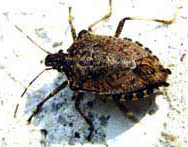Annette MaCoy
Cumberland County Horticulture Educator
 BMSB - what does it mean? It's short for Brown Marmorated Stink Bug, an exotic nuisance pest accidentally introduced into Pennsylvania several years
ago. "Brown" describes the mottled brown color of this shield-shaped bug. "Marmorated" describes the coppery to bluish-metallic punctures noticeable on the surface of the
head and body. "Stink" describes the pungent odor released from scent glands when the insect is disturbed, and "bug" describes this true bug with its piercing-sucking
mouthparts. BMSB was first officially identified in Allentown in 2001, and since then has been expanding its range to other parts of Pennsylvania, including the Capital
Region, and surrounding states.
BMSB - what does it mean? It's short for Brown Marmorated Stink Bug, an exotic nuisance pest accidentally introduced into Pennsylvania several years
ago. "Brown" describes the mottled brown color of this shield-shaped bug. "Marmorated" describes the coppery to bluish-metallic punctures noticeable on the surface of the
head and body. "Stink" describes the pungent odor released from scent glands when the insect is disturbed, and "bug" describes this true bug with its piercing-sucking
mouthparts. BMSB was first officially identified in Allentown in 2001, and since then has been expanding its range to other parts of Pennsylvania, including the Capital
Region, and surrounding states.
Why the concern? BMSB can be a real nuisance in the fall as adults congregate to find a warm protected site to overwinter, such as inside our homes,
in a manner similar to those more familiar pests, the multicolored Asian lady beetle and the boxelder bug. BMSB is a strong flyer and will emit a strong odor if it is
crushed. Once inside the home, it may become active on warmer sunny days during the winter. In spring, it emerges again to leave the home and complete its lifecycle. After
mating, females lay clusters of 20 to 30 light-green, barrel-shaped eggs on the underside of leaves, continuing to lay up to 400 eggs by late summer. The nymphs hatch from
the eggs in about a week and go through five stages of development, or instars. First instar nymphs are small and reddish-yellowish in color; later stages are darker in color
and look more like the adults.
Adults are about ½ inch in length with the characteristic shield shape of stink bugs, almost as wide as long. To distinguish BMSB from native
grey-brown stink bugs, look for alternate light and dark bands on the antennae. BMSB also has light and dark bands on the outer edges of the membranous wings. If you are
finding stink bugs in your home in winter, it is most likely BMSB; but you may bring a specimen to your local Penn State Extension office for positive identification.
The best option for control inside the home is to sweep or vacuum up the bugs and dispose of them outside. Do not leave the bag inside the vacuum
cleaner. Insecticides are not recommended for control inside the home. Outside, mechanical exclusion by sealing cracks and crevices with a good quality silicone or
silicone-latex caulk is the best approach to preventing entry of BMSB into the home.
Besides being a nuisance, BMSB has the potential to become an agricultural pest of crops such as peaches, apples, soybeans, and other legumes. It
feeds on the leaves and fruit of many different plants, including ornamentals, causing small necrotic spots to form. In its native eastern Asia, it is a known agricultural
pest. So far, in the eastern United States, BMSB has been noted as a nuisance pest only, but that may change as its population and range expands. So be on the lookout for
BMSB.
Read other articles about controlling insects & garden pests
Read other winter related gardening articles